Remember the ABA: New Jersey Americans (original) (raw)
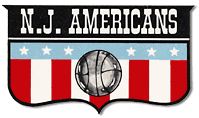 |
**Year of existence: 1967-68 Colors: Red, White and Blue Home Arena: Teaneck Armory (5,500) |
Interior 2 Coach: Max Zaslofsky Assistant Coach: Dick Schramm** Americans Fan Memories (Page 1) Americans Fan Memories (Page 2) New Jersey Americans Theme Song Americans/ABA History Articles (by Dick Schramm & Marty Machniak) |
|---|
Back to "Remember the ABA" Main Page
Did you see a New Jersey Americans game? Or, did you have a favorite Americans player? Contribute to this web page by describing your favorite Americans memories.
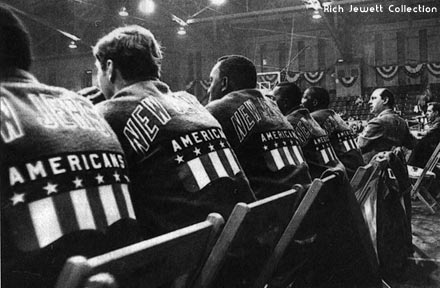 When ABA fans remember the New York Nets, they remember two ABA titles - won in 1973-74 and 1975-76. They also remember two Hall of Famers that played for the Nets - Rick Barry and Julius "Dr. J" Erving.
When ABA fans remember the New York Nets, they remember two ABA titles - won in 1973-74 and 1975-76. They also remember two Hall of Famers that played for the Nets - Rick Barry and Julius "Dr. J" Erving.
But before the Nets franchise had the money to acquire and sign any superstars, the franchise went through tough times.
The team started out in 1967 as the New York Americans.
In previous years, owner Arthur Brown had organized and sponsored several AAU and semi-pro teams in New York City. The original organizers of the ABA viewed Brown as the ideal choice to fund and operate New York's brand new ABA entry. The only problem? As much as he tried, Brown could not secure a suitable venue in or near New York City for his team. Some arenas were already booked solid. Other arenas had owners and operators who did not wish to "rock the boat" and upset New York's existing NBA franchise, the New York Knicks. In the fall of 1967, time was running out for the team to find a home.
After considering all of his meager options in the Big Apple, Brown finally decided on the best available alternative - the Teaneck Armory in Teaneck, New Jersey. Due to this last minute move, the team officially changed its name to the "New Jersey Americans." Brown hoped that the franchise might draw some interest from area basketball fans who lived closed to Teaneck, but did not want the hassle of driving to a busy New York City location. He also hoped that, despite the move, the team might attract at least some press and fans from New York.
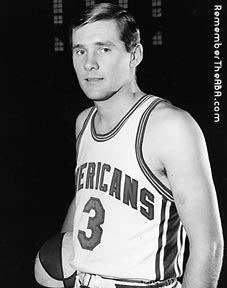 |
In the fall of 1967, the Americans/Nets franchise started out with these players. Tony Jackson (#25, upper left) was a sweet outside shooter. He was New Jersey's most consistent scoring threat throughout the 1967-68 season. Walt Simon (#4, above middle) would stick with the team through the 1969-70 season. He was last of the "original Americans" to play for the franchise. He then played for the Kentucky Colonels until 1974 and became the "last of the Americans" to play in the ABA. Dan Anderson (#20, above right) exploded out of the gate with 41 points in New Jersey's very first game on October 23, 1967. This became his ABA career high, as he was never able to duplicate this initial outburst. Bobby Lloyd (#3, left) sat on the bench during the first half of the season. But later in the season he broke into the starting lineup and helped push the Americans into a tie for the last playoff spot in the ABA's Eastern Division. |
|---|
He was able to put together a respectable squad. The coach was Max Zaslofsky. Zaslofsky had previously coached several of Brown's AAU teams.
At guard, the Americans had Tony Jackson (a former All-American out of St. John's), Bobby Lloyd (a good ballhandler out of Rutgers), and Mel Nowell (teammate of John Havlicek at Ohio State).
At forward, the Americans had Art Heyman (a volatile personality with plenty of hustle and talent), Walt Simon (a solid pro who would eventually play seven consecutive years in the ABA) and Bruce Spraggins (a talented rookie out of Virginia Union).
The center was 6-10 Dan Anderson, who had anchored some of Brown previous AAU and semi-pro teams. Jim Caldwell, out of Georgia Tech, backed up Anderson.
Anderson surprised everybody in New Jersey's opening game at the Armory, played on October 23, 1967. He scored 41 points - a very short-lived ABA single-game record - as the Americans lost to the visiting Pittsburgh Pipers 110-107. But Anderson was never able to duplicate this stellar effort.
For the first several months of the 1967-68 season, the Americans struggled to keep up in a series of high-scoring shootouts. On November 2, 1967, in New Orleans, the Buccaneers crushed the Americans 141-117. The 141 points for the Bucs established a new ABA high mark. On November 27, 1968, in Louisville, the Kentucky Colonels humiliated the Americans 138-100. And, on December 19, 1967, the Pipers pounded the Americans in PIttsburgh, 146-124. The 146 points for the Pipers set still another ABA high mark. And, Pittsburgh's 80-56 halftime lead also set a new ABA record for most points scored in a half.
| The Americans struggled in the early stages of the 1967-68 season. Fiery Art Heyman (#40, above left) clashed with Coach Max Zaslofsky (right), and was soon traded to the Pittsburgh Pipers for Barry Leibowitz. While the Americans suffered a large number of blowout losses, Tony Jackson (#25, above middle) kept the Americans close in many games with his scoring and hustle. Dan Anderson (#20 above middle and right) had his moments, but needed some help in the middle. In the photo above right, Anderson floats through the lane for two points against the Pipers. | 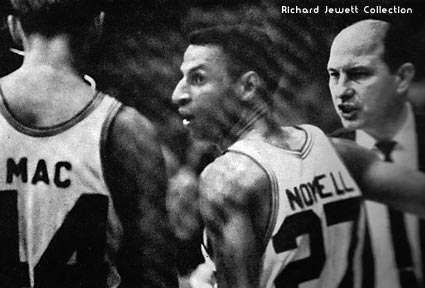 |
|---|
Tony Jackson was New Jersey's best offensive player, with a deadly outside shot. But opposing coaches began to employ defenses designed to limit his effectiveness. Ultimately the Americans made several major trades to boost their offensive firepower. First, they traded Heyman to Pittsburgh for Barry Leibowitz, a former Long Island University star. Then, they traded littled-used Caldwell to the Kentucky Colonels for sharpshooter Stew Johnson. Finally, after Leibowitz didn't pan out, they sent him to the Oakland Oaks for high-scoring Levern "Jelly" Tart. Tart was the leading scorer in the ABA at the time of the trade - at 26.7 points per game. He scored at a 23.5 ppg clip for New Jersey the rest of the year.
At the mid-point of the season, the Americans also added Hank Whitney, a 6-7 enforcer, to their roster. Whitney was not only a rugged rebounder, he could also score in the paint. He added another 16.0 ppg for New Jersey.
With Jackson, Tart and Johnson to shoot, Lloyd to distribute the ball, and Whitney and Anderson to clear the boards, the Americans started to play winning basketball. In March 1968, the Americans went on a "mini" playoff push. On March 12, Whitney poured in 34 points at the Armory to lead the Americans past the division-leading Pittsburgh Pipers, 126-112. The next night, also at the Armory, Lloyd scored 26 points to help the Americans defeat the Denver Rockets, 96-87. It was New Jersey's very first victory over the Rockets.
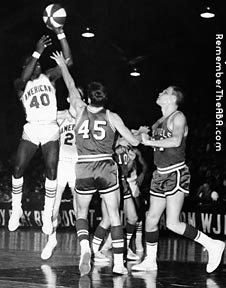 |
New Jersey enjoyed a strong late season surge with the help of these three players. Levern Tart (left, #40, shooting over several Kentucky Colonels) came to the Americans from the Oakland Oaks. He was the top scorer in the ABA with the Oaks, and he continued his high-scoring ways in New Jersey. The Americans signed Hank Whitney (#44, above left, faking Denver's Tom Hoover out of his shoes) from the Eastern League. Whitney was a strong rebounder and a tenacious hustler in the paint. Interestingly, he was a teacher in the New York City school system and actually maintained his teaching position during the season. Finally, Bruce Spraggins (#30, above right, dunking over Ira Harge of the Pipers) elevated his game and helped the Americans to a few comeback victories. |
|---|
In March 1968, the Americans went on a "mini" playoff push. On March 12, Whitney poured in 34 points at the Armory to lead the Americans past the division-leading Pittsburgh Pipers, 126-112. The next night, also at the Armory, Lloyd scored 26 points to help the Americans defeat the Denver Rockets, 96-87. It was New Jersey's very first victory over the Rockets.
Ultimately, the Americans tied the Kentucky Colonels for fourth place in the Eastern Division with a 36-42 record. A special one-game playoff was scheduled between the two teams to decide which team would qualify for the regular playoffs. The game was scheduled to be played at New Jersey. However, the Teaneck Armory was booked by a circus the entire week of the playoff game.
The Americans decided to move the game to Commack Arena on Long Island. What followed truly became the stuff of ABA legend.
When players, fans and reporters arrived at Commack Arena the evening of the game, the scene was chaotic. Workers hired by the Americans were feverishly trying to tape new 3-point lines onto the court. Parts of the floor appeared to have gaps and holes. Some areas of the court were unstable. There were numerous player complaints about goal padding, floor marking and even the height of the baskets.
Walt Simon observed: "This floor is a shame. You step on one side and another side comes up. That's dangerous."
Levern Tart recited a litany of obvious problems: "One basket seems a little higher than the other. And the 25-foot arc looks a little crooked. And there isn't any padding on the backboards or basket supports. It looks like things have been put up too quickly."
Colonels coach Gene Rhodes summed up the condition of the court by saying: "It's something out of Rube Goldberg!"
Others at the game also recall that parts of the court were very slippery. This was apparently the result of condensation from hockey ice directly underneath the court (Commack was the home of the Long Island Ducks of the Eastern Hockey League).
Despite the bizarre conditions, most of the Americans players were suited up and ready to play by game time. But, only 3 or 4 Colonels bothered to dress. After Kentucky refused to play, a call was placed to ABA Commissioner George Mikan in Minneapolis. After consulting with Americans and Colonels representatives, Mikan finally ordered the game forfeited in favor of the visiting Colonels. "I just don't want anyone injured," explained Mikan.
A slim crowd of about 400 had showed up for the game. Many of these fans had waited a full hour after the scheduled tipoff, hoping that the game would still go on. When the forfeit was announced over the P.A. system, many fans in the small crowd gave a sarcastic cheer. To add insult to injury, the Americans had given out numerous free tickets to their one-game playoff, without any special markings. When a line formed for refunds, many of the free ticketholders got in line with paying customers. The arena's ticket crew mistakenly gave refunds on about 80 complimentary tickets. A short time later, Americans owner Brown stormed out of the arena, saying to his own coach, Max Zaslofsky: "Come on, let's get out of this stinking joint."
The next day, Brown bitterly complained about Mikan's decision to forfeit the game. He threatened to sue Mikan and the ABA. In response, Mikan told the Louisville Courier-Journal: "I suppose Brown has the right to go to court. That's his opinion. I made this ruling for the good of the league. I don't want to try it in the papers." For a short time, the league actually considered flying the Americans AND the Colonels to Minneapolis for a special "replay" of the game. The winner would have simply stayed put in Minneapolis to face the Minnesota Muskies in Game 1 of a regular 5-game playoff series. A scorecard was even printed for Minneapolis fans who (for inexplicable reasons) might have wanted to see the game. Eventually the league decided against a replay - the Colonels started their playoff series with Minnesota and that was the end of the saga.
After the fiasco, Brown was asked by several reporters whether the Americans might move to Commack Arena for their next season. Brown harshly responded: "I cannot see any possibility of negotiating with these people. Anyone in the arena business should know that what's here is inadequate and improper. We definitely won't be here next year!" The manager of Commack Arena, John Steele, shot back: "I wouldn't want Brown here now for all his millions and I told him so."
But in the summer of 1968, Brown decided that the Americans could not survive in New Jersey. He announced his plans to move the team into the New York area -where he had intended to base the team in the first place. It would play as the "New York Nets." And where would the Nets play all of their home games for the 1968-69 season? Commack Arena, of course!
Americans Fan Memories (Page 1)
Americans Fan Memories (Page 2)
New Jersey Americans Theme Song
Americans History - The Beginning (Part I of a series of articles by Marty Machniak and Dick Schramm, Americans assistant coach - PDF format)
AMERICANS YEAR-TO-YEAR RESULTS
1967-68 Season
Record: 36-42, Tied for Fourth Place in Eastern Division
1968 Playoff Results:One Game Playoff at New Jersey vs. Kentucky Colonels (36-42) for Fourth Place and Playoff Berth
Colonels won by Forfeit, 2-0, due to unplayable conditions
1968-69 Season: Franchise moved to New York and became the New York Nets.